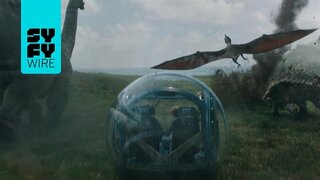Create a free profile to get unlimited access to exclusive videos, sweepstakes, and more!
We're Halfway to Creating Fully Artificial Living Yeast Cells
Make way for the era of bespoke beer and bread.
The geneticists at InGen pulled off a scientific magic trick when they created the first dinosaurs at Jurassic Park. The actual process is almost certainly too complicated to fully explain onscreen (or in a few paragraphs) but Mr. DNA gives us the broad strokes. DNA, he tells us, is the blueprint of any organism, dinosaur or otherwise. Time, however, comes for all things, even dinosaur DNA preserved inside mosquitos trapped in amber. So, the dinosaur genomes InGen scientists recovered were incomplete.
RELATED: Mr. DNA Returns in 'Long-Lost' Jurassic Park Training Video From the 1990s
After sequencing the recovered DNA samples, InGen’s team of geneticists led by Dr. Henry Wu (BD Wong) identified gaps and filled them in with genetic information from frogs (to their ultimate dismay, but that’s a different article). Fiddling with the genome is necessary when you’re making genetically modified dinosaur-shaped chimeras, but real-world scientists use similar techniques. Recently, a team of researchers at Sc2.0 project reached a milestone when they successfully created yeast cells with half-artificial genomes. The results were published in a trio of papers in the journals Cell and Cell Genomics.
How Scientists Built an Artificial Yeast Farm
We’ve created artificial microbes in the past, but in each of those cases, researchers were working with viruses or bacteria. There’s no denying their work is impressive, but viruses and bacteria have relatively little genetic information and simple body structures. Depending on who you ask, viruses aren’t even alive, and bacteria lack a nucleus and other organelles. Moreover, most bacterial genomes have only a single chromosome to deal with. By contrast, eukaryotic life like yeast, plants, and animals are significantly more complex with multiple chromosomes all working in tandem.
One of the primary things researchers did was take out the trash in the genome of Saccharomyces cerevisiae, otherwise known as common baker’s or brewer’s yeast. They sifted through the genome in search of repeating sequences that don’t encode for anything and removed them. Then they gathered up every DNA sequence that encodes for RNA transfer, removed them from their existing chromosomes, and bunched them all together on an entirely new “neochromosome.”
RELATED: Scientists Pulled a New Type of Virus from the Deepest Spot in the Ocean
RNA transfer is critical to the success and survival of the cell, and they are hot spots for genetic chaos. Having them all in one place gives scientists a single target when dealing with those issues. They also modified 6.5 of the 16 native chromosomes in a yeast cell and gave the yeast a genetic reshuffle command which mixes and remixes genes. The results are endless versions of artificial yeast cells which scientists can pick through and selectively breed for desirable traits.
Synthetic Yeast Could Make Medicine and Fuel, Better Beer and Bread
Getting from artificial chromosomes to a half-artificial cell was a laborious and painstaking process more than a decade in the making. Researchers created separate strains of yeast, each of which contained a single artificial chromosome. Then they bred them together to create baby yeast with two artificial chromosomes. Then they bred those together and so on, replacing native chromosomes with artificial ones, one at a time.
When the first artificial chromosome was introduced into the genome, it created a number of bugs which had to be edited and fixed. When modified yeast reproduced and added an additional artificial chromosome to their offspring, new – sometimes more complex – errors popped up which also had to be fixed. One step, one chromosome, and one revision at a time, the team succeeded at cresting the halfway point between wholly natural and wholly synthetic.
RELATED: The coolest dinosaur attacks in the Jurassic Park franchise
Artificial yeasts could be created to better resist environmental threats, work faster, and produce more. That’s obviously good news for bread and beer makers but there’s no reason we have to stop there. Scientists could engineer yeast to produce all kinds of things including medicines and fuels. In addition to the practical applications, there’s also the pure science of tinkering with biology to see how things work.
The genomes of these artificial years are so different from natural yeast that they no longer represent how yeast are made but instead how they can be made. If all organisms exist within a spectrum of biological possibility, then artificially constructed genomes are probing the boundaries of that spectrum. To get to a fully synthetic cell, the team will have to keep breeding and tinkering, replacing native chromosomes and moving around genes one and two at a time. They hope to have an entirely artificial yeast roughly a year from now. Hopefully the monster yeast doesn’t break through the fences and eat everyone in sight.
Catch the Jurassic World Collection streaming now on Peacock.
































